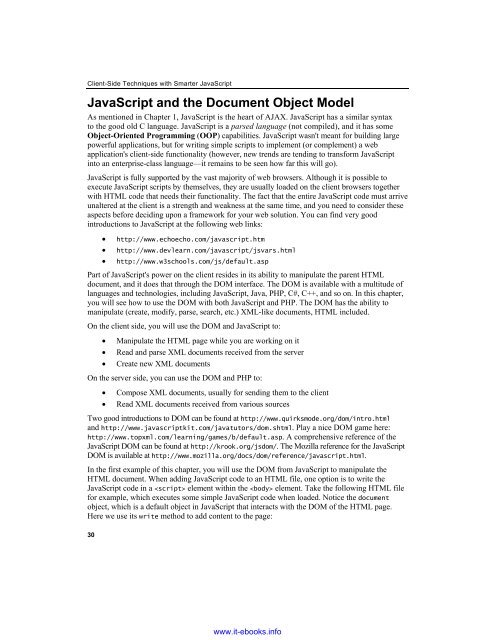AJAX and PHP
You also want an ePaper? Increase the reach of your titles
YUMPU automatically turns print PDFs into web optimized ePapers that Google loves.
Client-Side Techniques with Smarter JavaScript<br />
JavaScript <strong>and</strong> the Document Object Model<br />
As mentioned in Chapter 1, JavaScript is the heart of <strong>AJAX</strong>. JavaScript has a similar syntax<br />
to the good old C language. JavaScript is a parsed language (not compiled), <strong>and</strong> it has some<br />
Object-Oriented Programming (OOP) capabilities. JavaScript wasn't meant for building large<br />
powerful applications, but for writing simple scripts to implement (or complement) a web<br />
application's client-side functionality (however, new trends are tending to transform JavaScript<br />
into an enterprise-class language—it remains to be seen how far this will go).<br />
JavaScript is fully supported by the vast majority of web browsers. Although it is possible to<br />
execute JavaScript scripts by themselves, they are usually loaded on the client browsers together<br />
with HTML code that needs their functionality. The fact that the entire JavaScript code must arrive<br />
unaltered at the client is a strength <strong>and</strong> weakness at the same time, <strong>and</strong> you need to consider these<br />
aspects before deciding upon a framework for your web solution. You can find very good<br />
introductions to JavaScript at the following web links:<br />
30<br />
• http://www.echoecho.com/javascript.htm<br />
• http://www.devlearn.com/javascript/jsvars.html<br />
• http://www.w3schools.com/js/default.asp<br />
Part of JavaScript's power on the client resides in its ability to manipulate the parent HTML<br />
document, <strong>and</strong> it does that through the DOM interface. The DOM is available with a multitude of<br />
languages <strong>and</strong> technologies, including JavaScript, Java, <strong>PHP</strong>, C#, C++, <strong>and</strong> so on. In this chapter,<br />
you will see how to use the DOM with both JavaScript <strong>and</strong> <strong>PHP</strong>. The DOM has the ability to<br />
manipulate (create, modify, parse, search, etc.) XML-like documents, HTML included.<br />
On the client side, you will use the DOM <strong>and</strong> JavaScript to:<br />
• Manipulate the HTML page while you are working on it<br />
• Read <strong>and</strong> parse XML documents received from the server<br />
• Create new XML documents<br />
On the server side, you can use the DOM <strong>and</strong> <strong>PHP</strong> to:<br />
• Compose XML documents, usually for sending them to the client<br />
• Read XML documents received from various sources<br />
Two good introductions to DOM can be found at http://www.quirksmode.org/dom/intro.html<br />
<strong>and</strong> http://www.javascriptkit.com/javatutors/dom.shtml. Play a nice DOM game here:<br />
http://www.topxml.com/learning/games/b/default.asp. A comprehensive reference of the<br />
JavaScript DOM can be found at http://krook.org/jsdom/. The Mozilla reference for the JavaScript<br />
DOM is available at http://www.mozilla.org/docs/dom/reference/javascript.html.<br />
In the first example of this chapter, you will use the DOM from JavaScript to manipulate the<br />
HTML document. When adding JavaScript code to an HTML file, one option is to write the<br />
JavaScript code in a element within the element. Take the following HTML file<br />
for example, which executes some simple JavaScript code when loaded. Notice the document<br />
object, which is a default object in JavaScript that interacts with the DOM of the HTML page.<br />
Here we use its write method to add content to the page:<br />
www.it-ebooks.info


